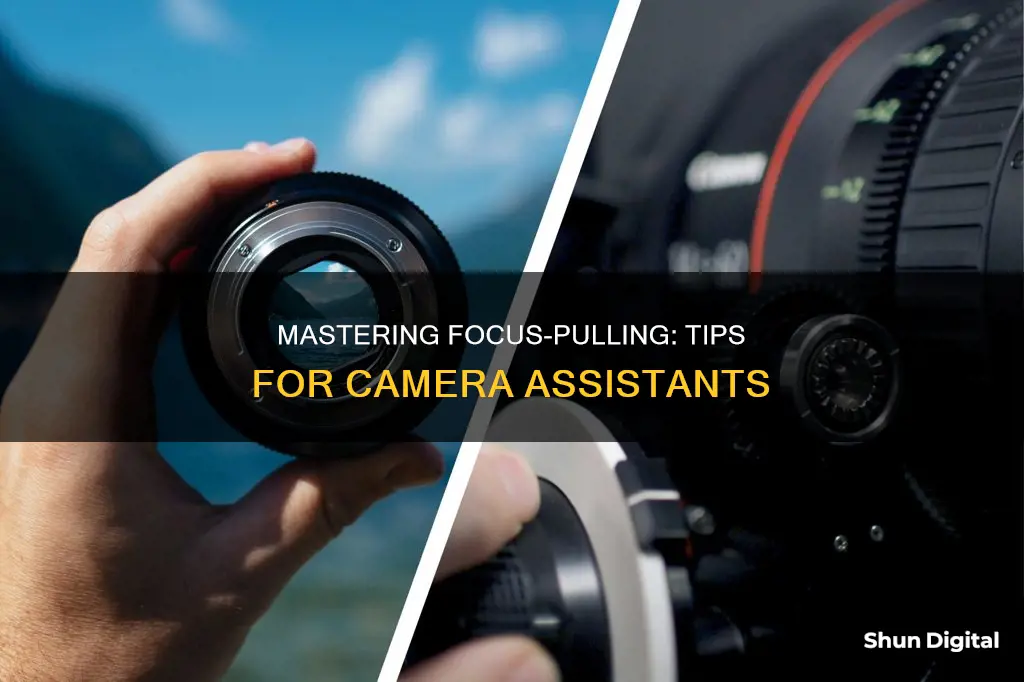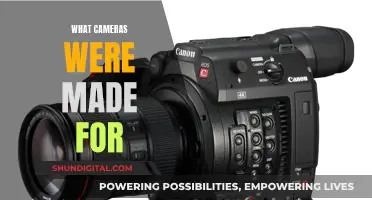
Pulling focus is a crucial yet challenging task in filmmaking, ensuring the camera captures sharp and usable images. The 1st Assistant Camera (AC) or focus puller is responsible for maintaining the camera lens's focus on the subject or action being filmed. It involves shifting the lens to keep the subject in focus as they move or as the camera changes position. While it may sound simple, it requires a unique set of skills, including estimating distances, understanding lens mechanics, and anticipating the movements of the camera operator and talent. The focus puller plays a vital role in guiding the audience's attention and enhancing the storytelling through precise focus manipulation. This role carries a lot of pressure as a soft or out-of-focus image can ruin a scene and pull viewers out of the narrative.
| Characteristics | Values |
|---|---|
| Job Title | First Assistant Camera (1st AC) or Focus Puller |
| Responsibility | Maintaining the camera lens's optical focus on the subject or action being filmed |
| Actions | Changing the camera lens's focus distance; shifting focus from one subject to another (rack focusing) |
| Tools | Tape measure, focus monitor, follow focus device |
| Skills | Judging distance, manipulating the lens, anticipating movements of the camera operator and talent |
| Challenges | Little room for error; high pressure; risk of being fired if focus is missed |
What You'll Learn

Understand the art and science of pulling focus
Pulling focus is both an art and a science. It requires technical skill and knowledge, as well as creativity and an understanding of storytelling. As a focus puller, you are responsible for guiding the audience's attention and enhancing the narrative through focus.
The science behind pulling focus involves understanding the technical aspects of optics and focus planes. This includes being able to accurately estimate distances, comprehending the non-linear nature of focus rings, and anticipating the movements of the camera operator and talent. It also entails knowing your gear and how to troubleshoot any issues that may arise.
To master the art of pulling focus, you must develop a well-trained eye for detail. This includes understanding the three points of interest on a subject's face (ears, eyes, and nose) and knowing how to use tools like focus peaking, focus assist, and pixel zoom to guide the audience's attention. As a focus puller, you should also be able to adapt to different lenses and shooting styles, such as using dots instead of numbers when marking focus points for Canon and Nikon lenses, which focus in opposite directions.
Additionally, pulling focus requires excellent communication and collaboration skills. Effective communication with the camera operator and director of photography is essential, as they rely on you to ensure the shot is in focus. Clear communication with the crew is also crucial, especially during rehearsals when you need to mark your follow focus and floor marks.
While the technical aspects of pulling focus are important, it's also crucial to understand the impact of focus on the narrative. As a focus puller, you play a vital role in guiding the audience's attention and enhancing the storytelling. This involves understanding how focus can craft different narratives and working with the director of photography and camera operator to ensure the focus serves the story.
Charging the Digi Cool Camera: A Quick Guide
You may want to see also

Know your gear and your style
Knowing your gear and your style is essential for a camera assistant, especially when it comes to pulling focus. Here are some detailed tips to help you master this skill:
- Understand the Basics: As a camera assistant, you need to grasp the fundamentals of focus pulling. This involves judging the distance between the camera and the subject and manipulating the lens to keep the subject in sharp focus. It's an art and a science that requires practice and a solid understanding of the technical aspects.
- Choose the Right Tools: Invest in high-quality tools specifically designed for camera assistants. This includes a good set bag, such as the DeWalt Open Top Tool Tote or a dedicated camera assistant bag. You'll also need an AC pouch or belt to carry your most-used tools and accessories. Ensure you have a variety of pens, markers, and screwdrivers in different sizes and types.
- Customise Your Gear: Don't be afraid to customise and repurpose your tools to suit your working style. For example, you could use a wrench to hold camera tape or find creative ways to organise your tools for easier access. Ask fellow camera assistants for tips and tricks to optimise your setup.
- Understand Your Lens: Take the time to learn about the lens you're working with. Understand how it breathes, how it works, and how it reacts in different environments. Each lens has its own unique characteristics, and by mastering these, you'll be able to pull focus more effectively.
- Practice with Your Gear: Familiarise yourself with your equipment through practice. The more you use your gear, the more you'll understand its capabilities and limitations. Experiment with different lenses, cameras, and tools to expand your skills and find your style.
- Stay Organised: A well-organised kit will make you more efficient on set. Keep your tools neatly arranged and easily accessible. Label your equipment and use colour-coding to your advantage. Stay on top of inventory management and regularly update your kit to fill any gaps.
- Be Adaptable: As a camera assistant, you need to adapt to different shooting styles and camera types. Understand the unique requirements of film and digital cameras and be prepared to work with various camera models. Stay flexible and be ready to tackle any challenges that come your way.
Remember, pulling focus is a skill that develops with experience. The more you work with your gear and understand your style, the better you'll become at pulling focus and delivering crisp, well-crafted visuals.
Mastering Camera Auto Focus: Calibration Techniques for Sharp Images
You may want to see also

Anticipate the movements of the camera operator and subjects
As a camera assistant, also known as a focus puller, you play a pivotal role in film production. Your primary task is to manage the camera's focus, a critical element that can make or break a scene.
To excel at this craft, you must master the art of anticipation. Here are some detailed tips to help you anticipate the movements of the camera operator and subjects:
Understand the Script and Blocking:
Study the script thoroughly and familiarise yourself with the blocking, which is the planned movement and positioning of the actors. By doing so, you can predict when and where the talent or camera operator will move, enabling you to adjust your focus marks accordingly.
Observe Acting Styles and Shooting Techniques:
Different acting styles and shooting techniques will influence the movements on set. For example, certain directors or actors may favour a more improvisational approach, while others stick closely to the script. Being able to recognise these nuances will help you anticipate movements more accurately.
Develop a Keen Eye for Detail:
Focus pullers need to be adept at estimating distances. Train your eye to accurately gauge the distance between the camera and the subjects. This skill will enable you to make precise adjustments to your focus marks, ensuring that the subjects remain in sharp focus.
Master the Use of Focus Marks:
The mapping and direction of focus marks on the lens and follow focus are essential tools for a focus puller. Develop a deep understanding of these marks and their relation to the movements of the camera operator and subjects. This knowledge will allow you to make seamless adjustments, ensuring that every shot is crisp and clear.
Stay Agile and Adaptable:
Even with careful planning, unexpected movements can occur. Embrace a mindset of agility and adaptability. Stay alert and be prepared to make spontaneous adjustments to your focus marks. This proactive approach will help you capture those magical, unscripted moments with crystal-clear focus.
Remember, the best takes often arise from talent improvisation. Your ability to anticipate and react to these moments will greatly enhance the final cinematic experience.
Replacing Sanyo Camera Battery: Step-by-Step Guide
You may want to see also

Marking the camera on a dolly to keep shots in focus
Marking the camera on a dolly is a challenging but fun part of being a camera assistant. The dolly shot is a common filmmaking technique that involves mounting a camera on a wheeled cart or dolly, which usually runs on rail tracks. This allows the camera to move towards, away from, or alongside the subject smoothly and controlled, almost as if it is floating.
To successfully pull focus on shots like these, you need to have consistent dolly grips and well-placed focus marks. Before laying down marks, you need a reference point on the dolly itself. This could be the bolt in the centre of one of the wheels, or you could place a piece of paper tape on the wheel or the dolly for an easier-to-see reference point.
The most basic dolly move is a push-in or pull-out, with a starting and stopping position. In this case, you will want marks at the beginning and end of the move, and possibly intermittent focus marks if you have the time or are working with a very shallow depth of field. Remember that the closer the subject gets, the shallower the depth of field gets, so place more marks closer to the subject.
If you are pushing into a landing point, you will have more focus towards the end of the move, and if you are pulling out from a subject, most of your focus marks will be at the beginning. You can use different coloured tape for the marks to make it easier to differentiate between them. It can also be helpful to write the numbered order in which the marks are hit on the tape.
More complicated dolly moves may have 3, 4 or 5 different landing points, and this is where different coloured tape is especially useful. Crab dolly moves, which go side-to-side perpendicular to a subject, are generally easier than push-ins or outs, but they can get complicated if you need to rack focus within the scene. Use the same guidelines as above and, at the very least, mark a "1" and a "2".
Dolly moves can be challenging, but if you know how to approach them, they can also be a lot of fun.
Launching Adobe Camera Raw: A Quick Guide
You may want to see also

Use a high-definition monitor to help maintain proper focus
As a camera assistant, one of your primary responsibilities is to maintain the camera lens's optical focus on the subject or action being filmed. "Pulling focus" refers to the act of changing the camera lens's focus distance in relation to the distance of a moving subject or camera from the focal plane.
Over the last decade, the increased use of digital cameras, higher-resolution video taps, and on-camera monitors have provided focus pullers with additional tools to help maintain proper focus. A high-definition monitor can be particularly useful when a fast-paced production does not allow time for the focus puller to set and check all the required marks or when no rehearsal is provided.
- Understand the three points of interest on a subject's face: the ears, eyes, and nose. Pay attention to the focus in these areas and use the tools on the monitor, such as focus assist, to help with your pull.
- Adjust the sensitivity of your focus assist. In situations with a lot of movement, a higher sensitivity will allow you to feel the movement of the actors and seamlessly pull to the point of focus. In scenarios with less movement, such as talking heads, turn down the sensitivity to reduce the amount of focus assist colour distracting from the image.
- Choose the right colour for your focus assist. Avoid colours that are common in the environment you are filming in. For example, if you are outdoors surrounded by greenery, avoid using green for your focus assist.
- Consider setting your monitor to black and white when focusing. A black-and-white image is considered better for focusing as you can see the contrast of the image more clearly.
- Ensure your monitor is set up correctly. The focus monitor should be as mobile as possible, and the size should be suitable for your eyes to focus on the whole image without causing strain.
Bosch Cameras: Where Are They Manufactured?
You may want to see also
Frequently asked questions
A focus puller, or first assistant camera (1st AC), is a film crew member responsible for maintaining the camera lens's focus on the subject being filmed. They ensure that the shot is properly focused on the intended subject or action in every take.
Pulling focus involves changing the camera lens's focus distance in relation to the distance of a moving subject from the focal plane or the changing distance between a stationary object and a moving camera. For example, if an actor moves closer or further from the focal plane, the focus puller adjusts the lens's distance setting accordingly.
Being a good focus puller requires a unique set of skills, such as accurately estimating distances, understanding the intricacies of camera lenses, and anticipating the movements of the camera operator and subjects. It's also important to have a solid understanding of focus marks and the various tools available, such as focus monitors and follow focus devices.







